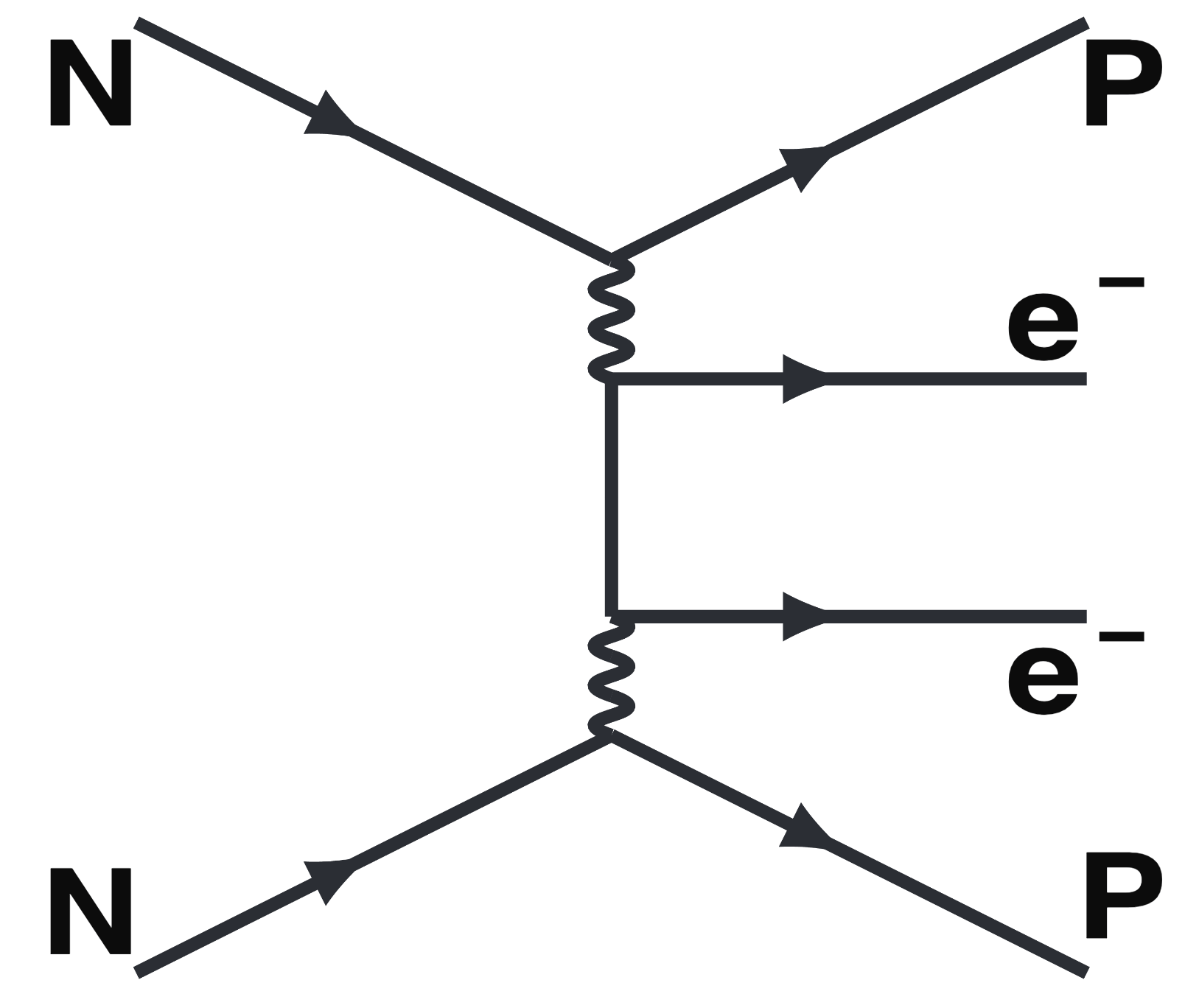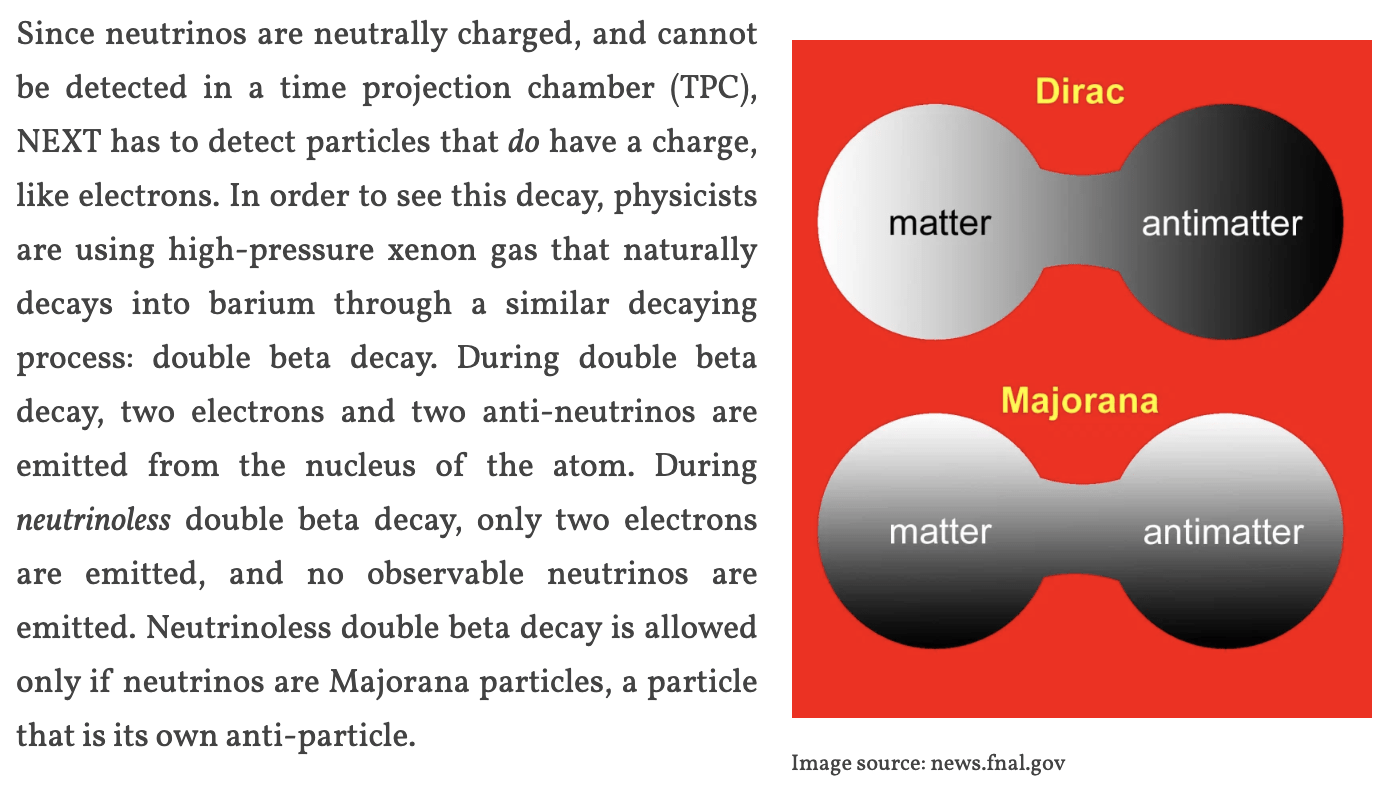NEXT
What does it measure?
NEXT (Neutrino Experiment with a Xenon TPC) is looking for an extremely rare radioactive decay by the name of neutrinoless double beta decay that can only occur if neutrinos are their own anti-particles. These Feynman diagrams show the two-neutrino double beta decay, that is predicted in the standard model and has been observed, and the theoretical neutrinoless double beta decay, which has never been observed.

Neutrinoless Double Beta Decay

How does it work?

How is it detected?
During the decay from xenon to barium, the two emitted electrons (also called beta particles) have high enough energy to ionize the gas as they shoot off the atom forming many low-energy electron-ion pairs in the xenon gas. In the time projection chamber, these ionization electrons drift through an electric field to an electroluminescence region where they are turned into photons (particles of light). With these photons, physicists are able to determine the path of the beta particles from the decay and determine their total energy very precisely and determine which of the two decays occurred.

IceCube
What does it measure?
The IceCube South Pole Neutrino Observatory is a rare example where nature provides us with an ideal test environment. Built over more than a cubic kilometer of Antarctic ice, IceCube studies one of the most elusive subjects known to physics: the neutrino. Neutrinos are produced through the so-called weak interaction, the name relating to the slow rate with which they are made.
The eponymous weakness of the neutrino’s production is also its crux; the method by which it is made is the only way by which it can be detected. Since neutrinos only weakly interact with matter around them, they tend to zip through matter totally unimpeded. So, to detect as many neutrinos as possible, IceCube uses a lot of matter.

There are three types, or flavors, of neutrinos: each corresponding to another member in a family of particles called leptons. These three kinds of neutrinos are the electron, muon, and tau neutrinos: corresponding to the electron, muon, and tau particles respectively. These six particles make up the leptons. When one of these neutrinos collides with an atom in the ice, it may turn in to its corresponding particle.
IceCube then measures the flavor, direction, and energy of the produced particle in order to gain insights on the properties of the parent neutrino. The goal is to understand the nature of the neutrino itself and the methods by which the highest of energy neutrinos are produced.

In September 2017, IceCube detected a very special neutrino. Looking into the sky, it appeared to come from a distant galaxy called TXS 0506+056: or, more succinctly, the Texas Blazar. Simultaneously, other observatories watched as the Texas Blazar flared out; spewing forth a plethora of X-Rays and Gamma rays. It would seem that these particles had just completed their billions of years journey to Earth from this unfathomably distant astrophysical object. The correlation between the neutrino’s apparent source and the Gamma activity marked a huge milestone in the field of multi-messenger astronomy.
How does it work?

The IceCube apparatus is composed of 5,170 basketball-sized light sensors, called DOMs (Digital Optical Modules), buried in the Antarctic ice. They are collected into kilometer-long groups on cables, and span a depth of 1.5 kilometers to 2.5 kilometers. When a neutrino passes through the ice and creates a new particle, the newly birthed particle emerges so quickly as to create a sonic boom of light, called Cherenkov radiation. The DOMs use built-in photo-multiplier tubes to turn the Cherenkov light into electrical signals, which are then digitized before being sent up to a hub on the surface. If enough of the DOMs observe light, then IceCube sends all of the DOM digital signals off to the IceCube computing headquarters in the University of Wisconsin, Madison, for further analysis.


DUNE
What does it measure?
DUNE is the future flagship US neutrino physics project, designed to study the properties of neutrinos as they propagate over hundreds of kilometers. Physicists will build two detectors, one stationed at Fermilab in Illinois and the other at Sanford Lab in South Dakota. From Fermilab, there is an intense neutrino beam that will allow neutrinos to travel 800 miles (1300 kilometers) through the Earth before striking its target at the Sanford Underground Research Facility (SURF). This distance gives the particles time to exhibit flavor transformations or oscillations. Neutrinos oscillate between three distinct flavors: muon, tau, and electron. At SURF, a massive liquid argon time projection chamber (LArTPC) will be used as the neutrino detector. With LArTPC, physicists will be able to determine the behavioral differences in terms of oscillations between anti-neutrinos and neutrinos.

How does it work?
Fermilab’s Main Injector Ring will smash energetic protons into a fixed target to produce short-lived particles called pions and kaons. These particles are aimed into a several-hundred-foot-long tunnel called the Long Baseline Neutrino Facility (LBNF), where they decay, transforming into an intense beam of neutrinos.

Most of the neutrinos sent from Fermilab will begin as the muon type, and DUNE will measure these particles as they cross state lines, transforming and passing through the far detector in South Dakota. The far detector will be filled with super-cold liquid argon. As the neutrinos interact with the argon atoms, they create charged particles that pass through the liquid argon detector. The charged particles ionize argon atoms that release electrons. These newly emitted electrons are then swept by an electric field and collected by wires. Using advanced electronics and software, scientists can reconstruct and analyze a complete 3-dimensional picture of each neutrino interaction to measure the neutrino oscillations.


The DUNE near detector involves several sub-components, including a liquid argon component, a solid scintillator tagger, and a high pressure argon gas component. The UTA-REST group is collaborating on the high pressure gas detector, using our experience in gaseous TPCs to realize its ambitious physics goals and optimize its performance.